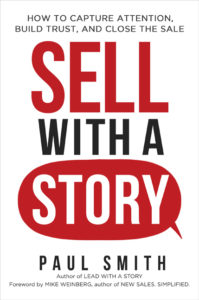Podcast: Play in new window | Download
Subscribe: RSS
Podcast (sell-with-a-story-series1): Play in new window | Download
Subscribe: RSS
 This series is dedicated to helping you tell better sales stories. But your first objective in a sales call shouldn’t be to tell any of your stories. It should be to get the buyer to tell you their stories. If you don’t hear their stories first, how will you know which of your stories to tell?
This series is dedicated to helping you tell better sales stories. But your first objective in a sales call shouldn’t be to tell any of your stories. It should be to get the buyer to tell you their stories. If you don’t hear their stories first, how will you know which of your stories to tell?
You wouldn’t trust a doctor who wrote you a prescription without listening to you explain your problem, would you? Of course not. Then why would a buyer accept the recommendation of a salesperson who did the same thing?
And if you’re unsure about what kind of stories you should want to hear from your prospects, here are the three most productive ones you should be asking for:
- A personal story — so you can get to know them better
- A story about their biggest problem — so you’ll know what kind of help they need
- A story about how their favorite supplier became their favorite supplier, so you can become their favorite supplier
Now, getting your buyers to talk is easy. Getting them to tell you stories requires a little more work. And you should want them to actually tell you stories not just talk, and for many of the same reasons why you should be telling stories to them:
- It’ll help you relax and listen better
- It’ll help you build a better relationship with them
- It’ll help you better remember what they say, plus
- When the story they tell is about the problem they’re facing, it helps you understand the context so you’ll have a better idea of the opportunity you’re up against.
So, here are five tactics being used by successful salespeople to get their buyers to tell stories:
- Shut Up and Listen – That’s probably the most obvious but underutilized tactic to get stories out of buyers. You know, human beings abhor silence in a conversation like nature abhors a vacuum. We’re desperate to fill the void with something. So, if you can resist the temptation for that something to be your voice, you have a near certain chance of that something being the buyer’s voice.
- Ask open-ended questions instead of closed-ended questions. For example, “What’s your number one problem area right now?” is a closed-ended question. The answer would be given in the form of a word or two, like “inventory” or “warehousing.” Compare that to an open-ended question like this: “How did you find out that your biggest problem was your biggest problem?” That question is more likely to elicit a story: “Oh, that would have been last month when our biggest customer placed an emergency order and we couldn’t find the parts they needed in the warehouse. So, we scheduled a special production run and expedited the parts to them at a huge expense. Then we ended up finding the parts they needed in the warehouse right where they should have been all along.” See, now you really know the problem you’re up against.
- Ask about specific events in time – For example, “Tell me about how you ended up in your current job,” or “What led up to losing your last major customer?” You see how it would be impossible to answer those questions without telling a story?
- Use “problem prompts” — That means, ask about specific problems you think your prospects might have with their current supplier. For example, if you ask, “Have you ever noticed that your Internet slows down after dinner?” your prospect is likely to launch into a story about the last time their internet connection slowed down after dinner.
- If all else fails, tell your stories first. If you want to get buyers to tell personal stories about where they grew up, you tell a personal story about where you grew up. If you want them to tell a story about a problem they’re having with their computer, you tell a story about a problem you’re having with your computer. You know this works because it works on you. When people tell you a story, the most likely thing that’s running through your head is “Hey, something like that happened to me once,” and now you can’t wait to tell them about it. Just remember, when the buyer interrupts and starts telling you her story, refer back to tactic #1. Shut up and listen.
So, here’s your homework for your next sales call:
- Create a list of open-ended questions to elicit the stories you want your buyer to tell. Take that list of questions with you and make sure to ask them.
- Come up with your own examples of those kinds of stories. That way, if you’re having trouble getting the buyer to tell you the kind of story you’re looking for, you can tell your story to prompt them.
Use these links to subscribe to this podcast on iTunes or Stitcher, or Podbean.
Source: Sell with a Story: How to Capture Attention, Build Trust, and Close the Sale, by Paul Smith.
—
 Paul Smith is one of the world’s leading experts on business storytelling. He’s a keynote speaker, storytelling coach, and bestselling author of the books Lead with a Story, Parenting with a Story, and Sell with a Story.
Paul Smith is one of the world’s leading experts on business storytelling. He’s a keynote speaker, storytelling coach, and bestselling author of the books Lead with a Story, Parenting with a Story, and Sell with a Story.


 Connect with him via email here.
Connect with him via email here.
Follow him on Facebook, LinkedIn, Twitter, and Instagram.
Sign up for his newsletter here to get one new story a week delivered to your inbox.



